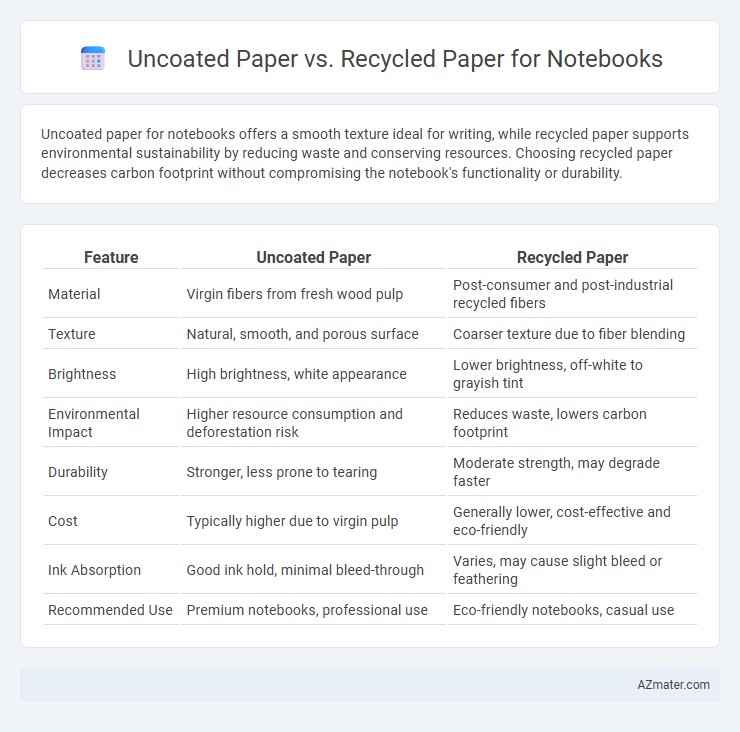Uncoated paper for notebooks offers a smooth texture ideal for writing, while recycled paper supports environmental sustainability by reducing waste and conserving resources. Choosing recycled paper decreases carbon footprint without compromising the notebook's functionality or durability.
Table of Comparison
| Feature | Uncoated Paper | Recycled Paper |
|---|---|---|
| Material | Virgin fibers from fresh wood pulp | Post-consumer and post-industrial recycled fibers |
| Texture | Natural, smooth, and porous surface | Coarser texture due to fiber blending |
| Brightness | High brightness, white appearance | Lower brightness, off-white to grayish tint |
| Environmental Impact | Higher resource consumption and deforestation risk | Reduces waste, lowers carbon footprint |
| Durability | Stronger, less prone to tearing | Moderate strength, may degrade faster |
| Cost | Typically higher due to virgin pulp | Generally lower, cost-effective and eco-friendly |
| Ink Absorption | Good ink hold, minimal bleed-through | Varies, may cause slight bleed or feathering |
| Recommended Use | Premium notebooks, professional use | Eco-friendly notebooks, casual use |
Introduction to Notebook Paper Choices
Uncoated paper offers a natural, smooth texture that enhances writing comfort and ink absorption for notebooks, making it a popular choice for those seeking a classic feel. Recycled paper, composed of post-consumer fibers, provides an eco-friendly alternative by reducing environmental impact while maintaining decent durability and print quality. Selecting between uncoated and recycled options depends on priorities like writing experience, sustainability, and budget considerations.
What Is Uncoated Paper?
Uncoated paper, commonly used for notebooks, is a type of paper that lacks a surface coating, resulting in a natural texture and higher absorbency ideal for writing or sketching. Unlike recycled paper, which is made from reclaimed materials, uncoated paper offers a smooth finish with excellent ink adhesion and brightness, enhancing readability and color vibrancy. Its environmental impact varies depending on the source of raw materials, but its tactile quality and print clarity make it a preferred choice for high-quality notebooks.
Understanding Recycled Paper
Recycled paper for notebooks is made from post-consumer waste, reducing deforestation and saving energy compared to virgin fiber papers like uncoated paper. It often features a slightly rougher texture and natural color variations, which enhance its eco-friendly appeal while maintaining acceptable durability and print quality. Choosing recycled paper supports sustainable practices and lowers the carbon footprint of notebook production.
Environmental Impact: Uncoated vs Recycled Paper
Uncoated paper typically requires more virgin wood fibers, resulting in higher deforestation rates and increased water usage compared to recycled paper, which utilizes post-consumer materials and significantly reduces landfill waste. Recycled paper production lowers greenhouse gas emissions by up to 45% and consumes less energy, making it a more sustainable option for notebooks. Choosing recycled paper helps conserve natural resources and supports circular economy principles, minimizing environmental footprints in paper manufacturing.
Writing Experience and Texture Comparison
Uncoated paper offers a smooth, natural texture that enhances ink absorption, reducing smudging and providing a superior writing experience ideal for fountain pens and markers. Recycled paper often features a slightly rougher surface due to fiber content variation, which can cause minor resistance during writing but supports eco-friendly goals. Both papers differ in texture and feel, with uncoated paper emphasizing refinement and recycled paper prioritizing sustainability without significantly compromising usability.
Durability and Longevity Factors
Uncoated paper in notebooks offers superior durability due to its natural fiber strength and resistance to tearing, making it ideal for frequent handling and writing. Recycled paper, while eco-friendly, often has shorter fibers that reduce its structural integrity, leading to increased wear and potential brittleness over time. However, advancements in recycling technology have improved recycled paper's longevity, balancing sustainability with practical use in everyday note-taking.
Printing Quality and Ink Absorption
Uncoated paper offers superior printing quality for notebooks due to its natural fiber surface, which allows ink to absorb evenly without smudging or feathering, resulting in crisp text and vibrant colors. Recycled paper can vary in printing performance depending on the fiber content and processing; lower-quality recycled fibers may cause uneven ink absorption, leading to duller images and potential bleed-through. Selecting uncoated paper generally enhances ink adhesion and sharpness, while recycled paper prioritizes environmental benefits but might require specialized inks or coatings for optimal print results.
Cost Considerations: Which Is More Affordable?
Uncoated paper typically costs less than recycled paper due to lower processing and raw material expenses, making it a more affordable option for notebook production. Recycled paper often requires additional treatment and quality control to ensure durability and print clarity, which can increase its price. Businesses aiming to balance cost and sustainability may find uncoated paper more budget-friendly, while recycled paper offers environmental benefits at a slightly higher cost.
Sustainability and Eco-Friendly Certifications
Uncoated paper for notebooks often features superior biodegradability and is typically free from chemical coatings, enhancing its sustainability profile. Recycled paper, sourced from post-consumer waste, reduces deforestation and landfill impact by reusing fibers, often carrying eco-friendly certifications such as FSC Recycled or EcoLabel. Choosing notebooks with these certifications ensures adherence to environmental standards, promoting responsible forest management and minimized carbon footprints.
Choosing the Best Paper for Your Notebook Needs
Uncoated paper offers a smooth, natural texture ideal for writing and drawing due to its high absorbency and crisp finish, enhancing ink clarity and preventing smudging. Recycled paper provides an eco-friendly alternative by using post-consumer fibers, reducing environmental impact while maintaining durability and quality suitable for everyday notebook use. Selecting between uncoated and recycled paper depends on prioritizing tactile experience or sustainability in notebook production and use.

Infographic: Uncoated paper vs Recycled paper for Notebook
 azmater.com
azmater.com